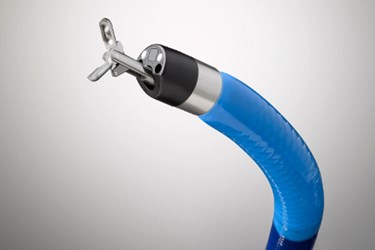Boston Scientific Gains FDA Clearance For SpyGlass DS Direct Visualization System

Boston Scientific announced FDA clearance for its SpyGlass DS Direct Visualization System, an updated version of their single-operator technology for examining bile and pancreatic ducts. The updates include better picture quality and several improvements that help simplify the procedure.
The SpyGlass system was first introduced in 2007 to improve on traditional endoscopic retrograde cholangiopancreatography (ERCP), a procedure that threaded a scope down the throat to the small intestine and collected two-dimensional, black-and-white x-ray images.
The SpyGlass system incorporated an endoscope that could be threaded directly into the bile ducts to provide direct visualization of the biliary tree and pancreas. Additional accessories could collect biopsies or break up bile stones as needed. The SpyGlass system was more durable than traditional methods and reduced the need for an additional exploratory surgery by providing greater functional versatility.
“It provides excellent direct visual access to the bile ducts and pancreas, helping obtain an accurate diagnosis and deliver effective treatment options in one procedure,” Douglas Pleskow of Beth Israel Deaconess Medical Center said in a 2011 press release, which provided updates on the efficacy of the system after four years of clinical use.
In 2008, Gastroengerology & Heptalogy spoke to Peter Draganov, a gastroenterologist and professor at the University of Florida’s College of Medicine, about the SpyGlass system, its advantages and limitations. According to Dragonov, the fiber optic portion of the system created images lower in quality than standard endoscopes.
Increasing visual quality was one of Boston Scientific’s main priorities with the newly updated system, according to a recent company press release. The new SpyGlass DS system offers an integrated digital sensor with a field of view that is 60 percent wider and produces images of higher resolution than the previous SpyGlass system. To prevent image degradation and probe reprocessing over time, the new system is fitted with a single-use scope that replaced after each procedure.
Furthermore, Boston Scientific’s development team improved the system’s efficiency and ease of use by incorporating “plug-and-play” technology and a controller that fits with standard ERCP carts.
“I’m extremely pleased with the overall functionality of the new SpyGlass DS System. It was quick and easy to set up (‘plug and play’), the image quality and stability excellent and four-way tip deflection intuitive. The system now enables endoscopists with ERCP expertise to perform cholangioscopy with or without intervention. My expectation is that this technology will increase our ability to diagnose and treat pancreatobiliary diseases and reduce the number of repeat ERCPs,” said Robert Hawes, from the Center for Interventional Endoscopy at Florida Hospital Orlando, in the press release.
According to the Boston Scientific press release, over a million ERCP procedures are performed each year.
